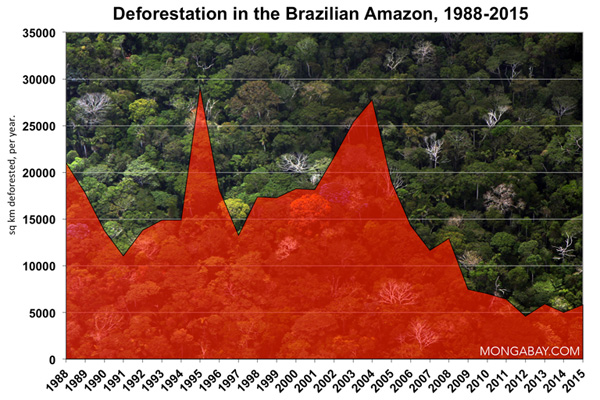The sharp reduction in deforestation in the Brazilian state of Mato Grosso since the mid-2000s will be difficult to replicate in other tropical countries where commodity production is a major driver in forest loss, argues a new study published in a special issue of the journal Philosophical Transactions of the Royal Society B.
The paper, titled “Export-oriented deforestation in Mato Grosso: harbinger or exception for other tropical forests?”, evaluated the conditions that enabled Mato Grosso to transition toward intensified land use and falling deforestation. It then compared these conditions to other tropical forest countries.
The authors, led by Ruth DeFries of Columbia University, concluded that while a significant proportion of tropical areas are experiencing similar commodity export-driven deforestation, few matched Brazil’s level of governance, technical capacity, and monitoring capacity, suggesting that “the feasibility of replicating Mato Grosso’s success with controlling deforestation is more limited.”
“Production landscapes to support distal consumption similar to Mato Grosso are likely to become more prevalent and are unlikely to follow a land-use transition model with increasing forest cover.”

Mato Grosso’s forests particularly benefitted from a shift from extensive clearing for low productivity — and economically marginal — cattle ranching to more intensified and more profitable soy and cattle production. The transition was such that the “area deforested in 2010 was only 11 per cent of the 1996–2005 historical average,” according to DeFries and colleagues. Other countries have comparably less extreme low-productivity land suitable for intensification.
Of 36 nations with more than 50 percent forest cover, the countries the researchers found to be the closest comparisons to Mato Grosso were Gabon, Sierra Leone, Indonesia, Malaysia and Peru (in terms of growth in agricultural exports); Liberia, Gabon, Brunei and Venezuela (in terms of urbanization rate); and Costa Rica, Vietnam and Malaysia (in terms of commercial agriculture as a deforestation driver). But none seem ready yet to follow in Mato Grosso’s footsteps.
“The experience in Brazil’s southern Amazon illustrates that deforestation can be controlled simultaneously with increases in agricultural production, but policies and incentives to reach these objectives are not yet in place in many other tropical forest regions,” said DeFries in a statement.

Overall, the trend in Mato Grosso is mirrored in the rest of Brazilian Amazon, where the deforestation rate in 2011-2012 was more than 80 percent below the most recent peak in 2003-2004. The drop has been attributed to a variety of factors, including macroeconomic trends, increased law enforcement, new protected areas, government policy, and private sector initiatives partly brought on by pressure from environmental campaigners. However some green groups fear that recent changes in Brazil’s forest policy, which governs how much forest a landowner must preserve, as well as an expanded push for new infrastructure projects could reverse some of the recent environmental gains. They point to a sharp rise in forest clearing since July 2012 as a possible indication of a reversal.
CITATION: DeFries R, Herold M, Verchot L, Macedo MN, Shimabukuro Y. 2013 Export-oriented deforestation in Mato Grosso: harbinger or exception for other
tropical forests? Phil Trans R Soc B 368: 20120173. http://dx.doi.org/10.1098/rstb.2012.0173